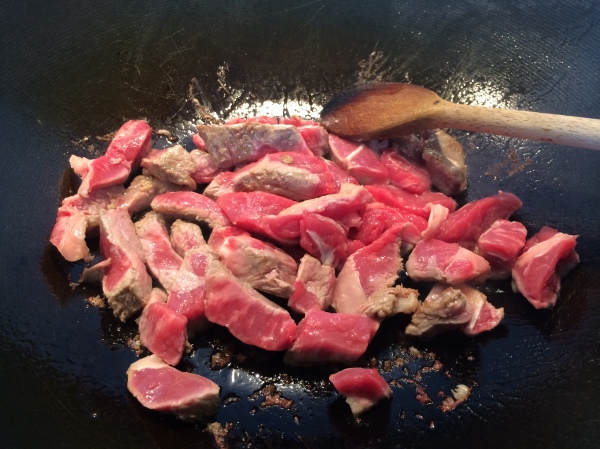When it comes to cooking, stir fry is a firm favorite in my book. Like sautéeing, stir frying involves cooking evenly-sized pieces of meat or vegetables on high heat. An important distinction however, is that stir fry dishes are made in a wok, which gives you a little more surface area to work with and an ability to cook different ingredients in different styles, with a small amount of oil. Stir frying works especially well with vegetables, so it’s also a great way to get in your 3 cups a day veggie quota.
I made this dish using gluten-free, black bean noodles from Explore Asian. I’ve have been raving about this product (review on the way!) but feel free to substitute with buckwheat noodles (soba) or something more traditional if you don’t mind the gluten / carbs. Also, I chose to use beef, but this recipe would work well with another kind of meat or tofu if you prefer.
Ingredients (serves 4)
- A large wok and a saucepan to boil water
- 200gms sirloin (New York strip) steak, cubed or cut into thin strips
- 1 bunch (around 8 stalks) asparagus
- 2 cups fresh kale
- 2 scallions (green onion) or shallot
- 1/2 a packet of black bean spaghetti by Explore Asian
- 1 tablespoon minced ginger
- 1 tablespoon minced garlic
- 1 tablespoon soy sauce
- 3 tablespoons vegetable oil
- 1 tablespoon sriracha
Method (20 minutes)
The key to a good stir fry is heat and speed, so prep your ingredients ahead of time: cut the beef into bite size cubes or strips. Chop the asparagus into 2 inch pieces, discarding woody ends. Cut the scallion on the bias (or finely slice the shallots) and wash and tear the kale leaves, discarding the stems.
In the meantime, bring a saucepan of water to a boil. Blanch the asparagus by adding to the boiling water for 2 minutes and then transferring to an ice bath to halt the cooking. Retain the water, reheat and once boiling, add half a packet of the black bean noodles. Cook until the noodles are al denté, about 6 minutes.
Sear the beef: add a tablespoon of vegetable oil to the wok and turn up the heat. Add the beef and keep it moving, ensuring you flip each piece around so that both sides cook evenly (about 3 minutes). Remove from the wok and set aside.
Wilt the kale: add another tablespoon of oil to the wok and once hot, add the garlic, ginger, sliced scallions / shallots and the sriracha. Throw in the torn kale and cook, stirring often, until the leaves are wilted.
At this point, you can push the kale to the sides of the wok and add the blanched asparagus. (You can also remove the kale and set aside.) Stir the asparagus, coating in the remnants of the prior ingredients, about 1 minute. Now add back the beef, add a splash of soy sauce and let it reduce. Mix in the kale and add the noodles. Cook the entire thing another minute or so, stirring vigorously. Serve hot and enjoy!













 Wash the uncut okra and lay flat on a paper towel. Pat the okra dry. Note** do not slice the okra while it’s wet. More importantly, do not wash the okra once it’s been cut — this is crucial if you are to get crisp texture rather than a soggy one.
Wash the uncut okra and lay flat on a paper towel. Pat the okra dry. Note** do not slice the okra while it’s wet. More importantly, do not wash the okra once it’s been cut — this is crucial if you are to get crisp texture rather than a soggy one. 



















